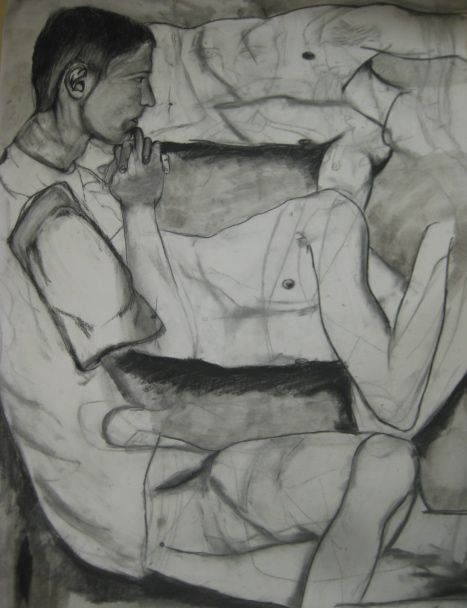In my reading, I came across an article entitled, “Laura Newman: On The Verge” which was posted on Sunday, September 5th, 2010 on ‘Two Coats of Paint’. The article was written by Sharon Butler, an artist who created the blog in order to share her collection of art criticisms. Her article displays excerpts from another essay entitled, “Laura Newman: Glass Walls and Billboards” which was written by Amy Sillman.
Sillman’s article explains Newman’s work in various different ways, some of which is confusing but some of which is also very intriguing. Laura Newman is a painter who uses abstract forms to create meaning. In her paintings, she lends a different perspective on simple shapes. She uses “parallax view,” a binocular cue that is the displacement in position of an object when viewed through two different lines of sight. Through parallax view, she creates double meanings. The subjects of Newman’s paintings are ordinary ones – houses, walls, fences, windows, horizon lines – however, she abstracts them in a way that they create slight optical illusions. She likes to fool the viewer’s eye into seeing the opposite of what is actually there; for example, close objects appear farther away, flat planes are cut out into separate shapes, minimal shapes represent something more complex, etc. She also embraces negative space in her paintings by incorporating it into the entire picture. In addition to paying close attention to shape and form, Newman also uses a variety of color to make her paintings all the more appealing. She layers unrelated colors that settle near each other to create lively work.
In the article “Laura Newman: On The Verge”, Butler includes a quote from Laura Newman that I enjoyed a fair bit. I thought that the quote explained her work perfectly: “[…] Suggestions of compression and restriction contrast with a sense of breaking free and soaring in thin air.” This quote describes how she utilizes space on the canvas to create interesting and thought-provoking compositions. I really like the fact that she creates double meanings within her work through parallax view. Her work is modern, fresh, and pleasing to look at. I also love her use of color, shape, and colors within shapes. Although she uses simple shapes to create a larger picture, she still finds a way to add complexity to her work as well, and it’s quite exciting.
I think that all of the different techniques that Newman factors into her paintings are absolutely relevant to talking about in art. Newman creates a whole new point of view on common every-day objects. When I look at her paintings, many different words come to mind: perspective, angle, shape, form, color, composition, negative space, positive space, light, dark, tone, range, etc. I also think that all of these things are the essence of her pieces. It is apparent that she intends to create different views, as well as simple yet complex compositions. Before reading these articles, I had never heard of Laura Newman, however I am now interested in her. I enjoy her spin on double meaning and parallax view, and how she takes ordinary things and makes them interesting. I also enjoy how she uses negative space as part of the whole picture, rather than leaving it as something forgotten. I think that negative space is equally important as the objects that take up the rest of the space in a painting. Essentially, I enjoy her style altogether. From a purely visual standpoint, her pieces evoke a sense of happiness to me. Overall, her choice of color is uplifting and amusing to look at. I am very glad to have come across this article and discovered a new artist.
Here are my two favorite paintings that I came across by Laura Newman on her website:
 |
| "Bloom." 2009; Acrylic & Oil; 72x64" |
 |
| "Windstorm."; 2007; Watercolor/Flashe; 22x30" |
Check her site out!: http://lauranewman.com/index.html
Link to Butler's article: http://www.twocoatsofpaint.com
Link to Sillman's article: http://artcritical.com/2010/09/04/sillman-newman/





































